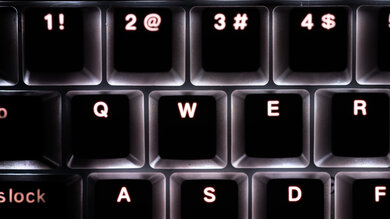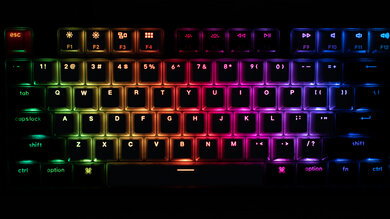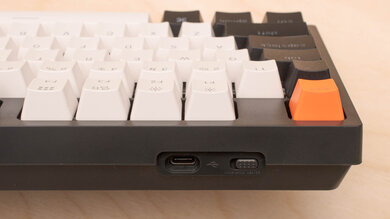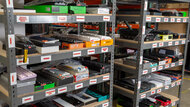The Keychron C1 is a good TenKeyLess mechanical keyboard for office use, and it's versatile enough for other uses as well. It has a sturdy-feeling build and a plastic frame that flexes only slightly. None of the keys rattle or wobble, and they're very stable while typing. The unit we tested is hot-swappable and has full RGB lighting with individually-backlit keys. It's also available in a non-hotswappable version or with white backlighting, and each version comes with Gateron Red, Blue, or Brown switches. Our unit has Gateron Browns, which don't take much force to actuate and provide good tactile feedback, although they have a fairly long pre-travel. Unfortunately, there's no companion software for customization.
Our Verdict
The Keychron C1 is satisfactory for gaming use. It has a solid-feeling build and full RGB lighting, but it only has decent latency and alright ergonomics with a tall profile and no included wrist rest. The Gateron Brown switches on our unit don't require much force to actuate and have good tactile feedback, but they have a long pre-travel distance. Unfortunately, there isn't any companion software for setting macros or reprogramming buttons; however, there are onboard lighting presets.
-
Impressive build quality.
-
Great typing quality.
-
Full RGB lighting with individually-backlit keys.
-
No companion software and no programmable keys.
-
Keyboard has a high profile and lacks an included wrist rest.
-
Keys have long pre-travel.
The Keychron C1 isn't suitable for use with mobile devices.
Note: Our testing methodology automatically considers wired-only keyboards unsuitable for mobile and tablet use. That said, this keyboard includes a USB-C to USB-C cable, so we tested it with a compatible iPad and Android device. We found it works with both devices, though some function keys don't work and it drains batteries at an increased rate, especially with backlighting on.
The Keychron C1 is a good keyboard for office use. The Gateron Brown switches on our unit are quiet, don't require much force to actuate, and provide good tactile feedback, although they have a long pre-travel distance. It's fully compatible with Windows and macOS, and the overall build feels sturdy. Unfortunately, the ergonomics are only alright as it has a high profile and doesn't include a wrist rest, so you may experience wrist pain after typing for prolonged periods.
-
Impressive build quality.
-
Great typing quality.
-
Comes with a USB-C to USB-C cable and a USB-A dongle.
-
No companion software and no programmable keys.
-
Keyboard has a high profile and lacks an included wrist rest.
The Keychron C1 is a satisfactory keyboard for programming use. It has a sturdy-feeling build, full RGB backlighting, and compatibility with Windows, macOS, and Linux. Unfortunately, the ergonomics are only alright as the keyboard has a high profile and doesn't include a wrist rest. The Gateron Brown switches on our unit provide a great typing quality. However, there's no companion software, so you can't reprogram keys without third-party software, which we don't test.
-
Impressive build quality.
-
Great typing quality.
-
Full RGB lighting with individually-backlit keys.
-
Compatible with Windows, macOS, and Linux.
-
No companion software and no programmable keys.
-
Keyboard has a high profile and lacks an included wrist rest.
-
Wired-only.
The Keychron C1 isn't well suited for entertainment or home theater PC use. While it has a solid-feeling build, good compatibility with major operating systems, and full RGB backlighting, it can't be connected wirelessly. You'll need to sit within cable distance of your entertainment or theater setup. It also lacks a trackpad, so you'll likely need to connect a mouse to navigate menus, although it does have media hotkeys.
-
Impressive build quality.
-
Great typing quality.
-
No companion software and no programmable keys.
-
Keyboard has a high profile and lacks an included wrist rest.
-
Wired-only.
-
Lacks a trackpad for navigating menus.
- 7.1 Gaming
- 4.2 Mobile/Tablet
- 7.6 Office
- 7.2 Programming
- 4.5 Entertainment / HTPC
Changelog
- Updated Jun 15, 2023: We've added a link to the newly-reviewed Keychron C1 Pro/C2 Pro in the Build Quality section of this review.
- Updated Mar 18, 2021: Review published.
- Updated Mar 16, 2021: Early access published.
- Updated Mar 09, 2021: Our testers have started testing this product.
- Updated Mar 08, 2021: The product has arrived in our lab, and our testers will start evaluating it soon.
Check Price
Differences Between Sizes And Variants
The Keychron C1 we tested is the hot-swappable version with Gateron Brown switches and full RGB backlighting. There's also a non-hot-swappable version, as well as a version with white-only backlighting. All versions are available with either Gateron Brown, Red, or Blue switches. You can see the label for our unit here.
Compared To Other Keyboards
The Keychron C1 is a versatile, budget mechanical keyboard that's essentially a Keychron C2, scaled down to a TenKeyLess (80%) layout. It offers compatibility across major operating systems, a sturdy-feeling build quality, and a respectable performance for a variety of uses at a budget price-point. This keyboard is a solid, entry-level choice for those who may be new to mechanical keyboards or for those interested in experimenting with different switches. For more keyboard options, check out our recommendations for the best keyboards, the best mechanical keyboards, or the best keyboards for Mac.
The Keychron C1 and the Keychron K8 are very similar TenKeyLess mechanical keyboards with a few notable differences. The C1 is a wired keyboard with a full plastic frame and better latency. On the other hand, the K8 connects wirelessly via Bluetooth, and the unit we tested has an aluminum plate, adding to the already solid-feeling build quality. They both have full RGB lighting and are hot-swappable, so you can use switches other than the default Gateron Red, Blue, or Brown switches available to both. The K8 also has an additional hot-swappable version with optical switches.
The Keychron K2 (Version 2) and Keychron C1 are mechanical keyboards with similar looks but different sizes and connectivity options. The K2 is a compact (75%) keyboard that connects wirelessly via Bluetooth and can connect with up to three devices, while the C1 is a TenKeyLess wired keyboard. Unfortunately, both keyboards are fairly tall and don't include a wrist rest. That said, we tested each of these Keyboards with Gateron Brown switches that don't require much force to actuate and provide great typing quality with good tactile feedback. They're also both available with linear Gateron red and clicky Gateron Blues, and both have hot-swappable versions available as well.
Both the Keychron C1 and Keychron C2 are nearly identical wired mechanical keyboards. The only discernable difference between the two is that the C1 is a TenKeyLess (80%) layout, while the C2 is a full-sized keyboard.
The Keychron C1 and the Ducky One 2 RGB TKL are both wired mechanical TenKeyLess keyboards. The Keychron is a decent hot-swappable office keyboard available with Gateron Red, Blue, or Brown switches. The Ducky is a very versatile keyboard primarily designed for gaming use and is available in a range of MX Cherry switches and backlighting options. The Ducky has companion software which the Keychron lacks, but it only controls lighting customization. However, the Ducky does support macro programming for any key, though it's done directly onboard.
The Keychron C1 and the Obinslab Anne Pro 2 are mechanical keyboards with significant differences. The Keychron is a decent TenKeyLess office keyboard that's hot-swappable and is available with Gateron Red, Blue, or Brown switches. On the other hand, The Obinslab is a compact (60%) keyboard well-suited to various roles but primarily designed for gaming use. It has much lower latency, and it's available with a wide range of Kailh, Gateron, or MX Cherry switches. It also has robust customization software, which the Keychron lacks.
The Keychron K8 Pro [K2 Pro, K3 Pro, K4 Pro, etc.] are much better than the Keychron C1, which belongs to the wider Keychron C series of keyboards. The K Pro Series are wireless keyboards with a much higher build quality thanks to their aluminum frames and PBT keycaps. They also have sound-dampening foam inside the case to reduce typing noise. Plus, they're all hot-swappable, meaning you can change the stock switches. That said, the C1 and other C series keyboards do have a hot-swappable variant, but they're more expensive than the base version.
Test Results
The Keychron C1 has a great, sturdy-feeling frame similar to the Keychron C2. It feels good to type on, and it only flexes slightly. The keys feel very stable, and the keycaps are doubleshot ABS, but they seem susceptible to showing oil shine from fingers. The feet are stable and don't collapse when you reposition the keyboard. However, if you're interested in a newer version of this keyboard that makes several revisions to the overall build quality with PBT keycaps and south-facing LEDs, check out the Keychron C1 Pro.
The Keychron C1 has alright ergonomics. Despite having two incline settings, it has a tall profile. It also doesn't come with a wrist rest, so you may experience wrist fatigue after typing for a prolonged period.
The Keychron C1 has full RGB lighting with individually-backlit keys and good color mixing with only a slight pink tint to the white lighting. You can cycle between lighting presets with a button on the top right of the keyboard. The model we tested has full RGB, but there's a variant of this keyboard that features only white backlighting as well.
The Keychron C1 has a detachable USB-C to USB-C cable. There's also an included USB-A dongle in case your computer doesn't have a USB-C port.
This keyboard is wired only, but if you're interested in a wireless board from the same manufacturer, check out the Keychron K Pro Series.
The Keychron C1 has a switch that toggles between Windows/Android and macOS/iPadOS, but It has no companion software for programming keys. Keychron recommends using either Karabiner or Sharpkeys for key remapping with macOS and Windows, respectively. For a 75% compact board that's much more customizable, check out the Keychron Q1.
Our unit has tactile Gateron Brown switches that provide good feedback and don't require much force to actuate. However, they do have a long pre-travel distance. During our tests, we noticed that many of the keys exhibited a small dip at the beginning of travel rather than a smooth transition up to the tactile point, although this wasn't noticeable during typing.
Our version of the Keychron C1 is hot-swappable, allowing you to swap the default switches for those of your choosing. There's also a non-hot-swappable version available, and both versions come with Gateron, Red, Blue or Brown switches.
The keys have standard spacing and feel very stable without any rattling or wobbling, even on the larger keys. Our unit has tactile Gateron Brown switches and provide a great typing experience with good feedback, though the pre-travel is fairly long. Unfortunately, it also has a high profile and there isn't an included wrist rest, so you may experience wrist fatigue during long typing sessions.
This keyboard is hot-swappable so you can use the switches you prefer, and it also has versions with clicky Gateron Blue or linear Gateron Red switches.
The Keychron C2 is quiet and unlikely to bother those around you in most work environments. We expect the clicky Gateron Blue switches to be louder, and the linear Gateron Reds to be even quieter.
The Keychron C1 has very good latency though some gamers may still prefer the lower latency of a high-end, dedicated gaming keyboard, especially for competitive and reaction-based games.
The Keychron C1 has no companion software, but the included quick start guide recommends using Karabiner and Sharpkeys third-party key remapping software for macOS and Windows, respectively. However, this isn't something we test. If you want a similar keyboard with dedicated software, check out the ASUS ROG Strix Scope TKL. If you'd like a barebones keyboard with dedicated customization software, check out the GLORIOUS GMMK PRO.
The Keychron C1 is fully compatible with both Windows and macOS and there's a switch on the side of the board to toggle between them. It also works in Linux when toggled to macOS compatibility, but the screen Brightness Up/Down buttons don't work.
Note: Our current methodology automatically counts wired keyboards as incompatible with mobile devices. However, this keyboard includes a USB-C to USB-C cable, so we tested it with a USB-C compatible iPad and Android device. The keyboard works normally with both devices but the F4, F5, and F6 buttons don't work. Also, the keyboard will drain your battery fairly quickly, especially with backlighting on.

































